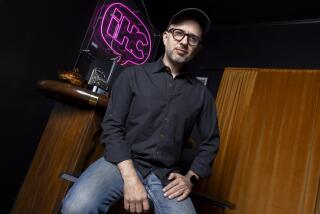A Coming Out for Underground Dance
- Share via
LAGUNA BEACH — They’re young. They’re hip. They’re sexy. And, to a large extent, they’re simple and rather self-absorbed.
They are Orange County’s trend-setters of the techno-industrial dance scene, who gathered late Thursday night at Club Postnuclear to see, be seen and dance, dance, dance.
It was here that Laguna Beach-based film and television producer Mark Lacey trained his camera eye to capture the pilot for an alternative dance-music TV show, which he says aims “to celebrate our freedom of expression, of dance, of art and of speech.”
The 23-year-old Lacey, who three years ago founded Real Pictures, a tele-production company, is hoping that his “CLUBunderground” program will shatter the traditional confines of the dance music show, and of television as well.
The 30-minute show is Lacey’s first full-length TV program, which he plans to market to cable and commercial TV networks. He said the show will fuse music, dance, performance art, poetry and some occasional drama, set in a “gritty” underground dance-club setting. Lacey, whose previous video work has mostly been commercials and music videos, said he will try to sell this pilot before shooting any more episodes.
Lacey said he came up with the idea for the show because he believes there exists an audience that is “hungry” for such an outlet, and because of his general disgust for nearly everything he sees on television.
“Everyone has been desensitized by TV, with its sex, religion and war,” Lacey said during an interview this week. “That’s worse than George Orwell’s ‘1984’ nightmare to me.
“And if I can make a difference by bringing TV to a new level, then that’s a step. That’s why I’m in this--to affect people in a positive way, by taking risks.”
When completed during the next two weeks, Lacey said his “CLUBunderground” pilot will include performance art and music clips, featuring, among others, 808 State, a quirky Icelandic alternative-rock band fronted by Sugarcubes’ singer and songwriter Bjork.
The footage Lacey and his crew shot at Club Postnuclear, a trendy South County underground nightspot with a no-alcohol policy, centered upon a crowd of about 200 sharply and scantily clad bodies gyrating to the continuous throb of post-Depeche Mode/New Order techno-industrial dance sounds.
Hand-held cameras moved through the crowd, often lingering at length on provocative, sweaty dancers--”hand-picked from clubs throughout Southern California,” Lacey said--who moved to the beat atop circular pedestals.
Certainly, this is a dance show of another realm than the teen-bops featured on MTV. As Lacey promised, his program takes risks, at least as far as projecting steamy, Madonna-esque sexuality.
One particularly eye-catching dancer, a young, muscular, short-haired blonde woman, vigorously swerved and thrust her hips, while dressed in heels and a full-bodied string outfit that concealed considerably less skin than an average bikini.
The dancing paused for one stage performance featuring a slender young man in a leather jockstrap-bondage get-up. As if an underground Chippendale’s dancer, he strutted and moved erotically before a flaming chalice. After touching two torches to the pyre, he waved the batons, rubbed them against his skin and “breathed” fire for the finale.
Other club-goers included a smattering of pedestrian folk, but most dressed to impress--themselves, if no one else. The dancers sported leather, psychedelic mini-dresses, black art-chic attire, safety pins and studded dog collars, rasta/hip-hop wear and plenty of makeup and hair spray.
When a microphone later was turned to the patrons outside the club, most of the young trendies were unable to express their freedom of speech in terms more compelling than cliches about sex, fun and saving the planet.
One of the more coherent comments came from a young brunette named Leanne, who urged: “Save the ozone layer, love each other and communicate.”
Another interviewee, John, asked his view of the future, responded, “long legs and high heels.” Moments later, he criticized television for its “severe exploitation.”
Others didn’t share Lacey’s disdain for TV’s narrow conventionality. Nicholas said he thinks television is “cool to watch and listen (to). It’s rad to sit down with.” Rob later agreed, saying “It’s pretty cool when Madonna’s on.”
Nevertheless, Lacey remains optimistic about both TV and his peers, whom numerous magazines and newspapers have tabbed “the nowhere generation.”
“I think TV is changing, and people are changing,” Lacey said. “The consciousness of people is changing. The Cold War is over; the environment is being destroyed. . . . People are thinking more about how to look at themselves. I think they’ll want to look more to themselves for happiness. . . .
“So,” Lacey said, “I don’t get discouraged.”
More to Read
The biggest entertainment stories
Get our big stories about Hollywood, film, television, music, arts, culture and more right in your inbox as soon as they publish.
You may occasionally receive promotional content from the Los Angeles Times.










